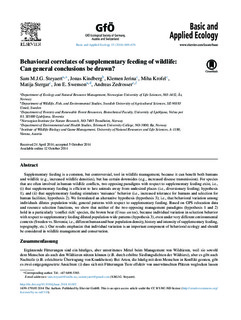| dc.description.abstract | Supplementary feeding is a common, but controversial, tool in wildlife management, because it can benefit both humans and wildlife (e.g., increased wildlife densities), but has certain downsides (e.g., increased disease transmission). For species that are often involved in human-wildlife conflicts, two opposing paradigms with respect to supplementary feeding exist, i.e., (i) that supplementary feeding is efficient to lure animals away from undesired places (i.e., diversionary feeding; hypothesis 1), and (ii) that supplementary feeding stimulates ‘nuisance’ behavior (i.e., increased tolerance for humans and selection for human facilities; hypothesis 2). We formulated an alternative hypothesis (hypothesis 3); i.e., that behavioral variation among individuals dilutes population-wide, general patterns with respect to supplementary feeding. Based on GPS relocation data and resource selection functions, we show that neither of the two opposing management paradigms (hypothesis 1 and 2) hold in a particularly ‘conflict rich’ species, the brown bear (Ursus arctos), because individual variation in selection behavior with respect to supplementary feeding diluted population-wide patterns (hypothesis 3), even under very different environmental contexts(Sweden vs. Slovenia; i.e., different human and bear population density, history and intensity ofsupplementary feeding, topography, etc.). Our results emphasize that individual variation is an important component of behavioral ecology and should be considered in wildlife management and conservation | |

